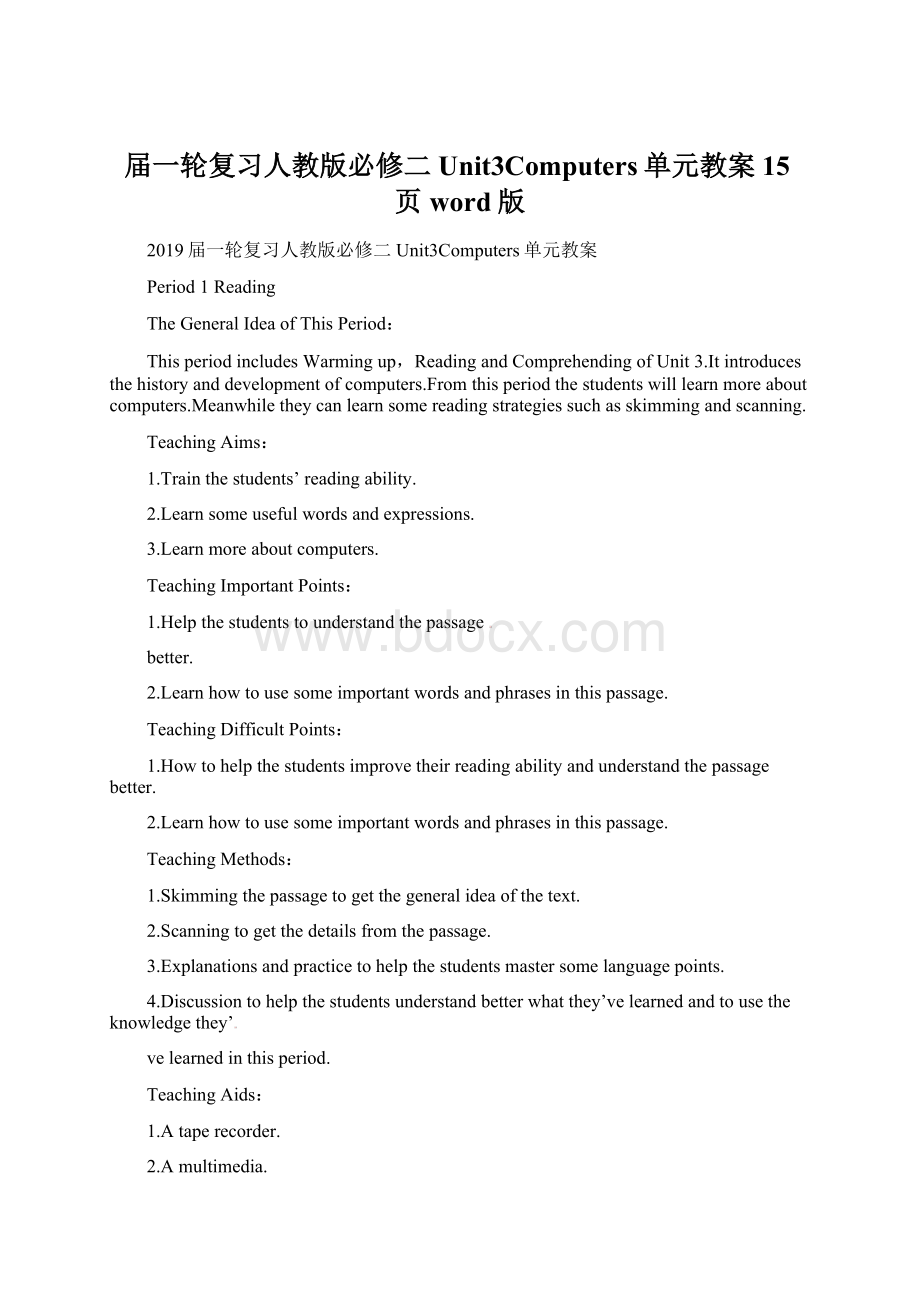届一轮复习人教版必修二Unit3Computers单元教案15页word版.docx
《届一轮复习人教版必修二Unit3Computers单元教案15页word版.docx》由会员分享,可在线阅读,更多相关《届一轮复习人教版必修二Unit3Computers单元教案15页word版.docx(22页珍藏版)》请在冰豆网上搜索。

届一轮复习人教版必修二Unit3Computers单元教案15页word版
2019届一轮复习人教版必修二Unit3Computers单元教案
Period1Reading
TheGeneralIdeaofThisPeriod:
ThisperiodincludesWarmingup,ReadingandComprehendingofUnit3.Itintroducesthehistoryanddevelopmentofcomputers.Fromthisperiodthestudentswilllearnmoreaboutcomputers.Meanwhiletheycanlearnsomereadingstrategiessuchasskimmingandscanning.
TeachingAims:
1.Trainthestudents’readingability.
2.Learnsomeusefulwordsandexpressions.
3.Learnmoreaboutcomputers.
TeachingImportantPoints:
1.Helpthestudentstounderstandthepassage
better.
2.Learnhowtousesomeimportantwordsandphrasesinthispassage.
TeachingDifficultPoints:
1.Howtohelpthestudentsimprovetheirreadingabilityandunderstandthepassagebetter.
2.Learnhowtousesomeimportantwordsandphrasesinthispassage.
TeachingMethods:
1.Skimmingthepassagetogetthegeneralideaofthetext.
2.Scanningtogetthedetailsfromthepassage.
3.Explanationsandpracticetohelpthestudentsmastersomelanguagepoints.
4.Discussiontohelpthestudentsunderstandbetterwhatthey’velearnedandtousetheknowledgethey’
velearnedinthisperiod.
TeachingAids:
1.Ataperecorder.
2.Amultimedia.
TeachingProcedures:
Step1Warmingup
1.Greetingthestudentsasusual.
2.Introducethetopicofcomputers
Showthefivepictures(anabacus,ahugecomputer,acalculator,aPC,anotebookcomputer)andgetthestudentsnametheminEnglish.Throughthistask,st
udentscanhaveageneralideaaboutwhattheyaregoingtolearn.Besides,studentsareexpectedtohaveadiscussionaboutwhattheyhaveincommonwhilelookingatthem.Andtheyarerequiredtousethegivenexpressionsintheirdiscussiontoexpresstheirideas.
T:
B
oysandgirls,todayIamgoingtointroducesomemachinestoyou.Nowlet’sseewhetheryoucannametheminEnglishcorrectly,andtalkaboutthem.Nowworktogetherwithyourpartnersandtrytofindoutwhattheyhaveincommon.
Twominuteslate,fivestudentsareaskedtotalkabouttheminclass.
S1:
AnabacusisanoldcalculatingmachineusedinChinauntilnow.
S2:
Ahugecomputerisbuilttosolvesomemathematicalpro
blems.But,inmyopinion,itistoobig.
S3:
Acalculatorisanewcalculatingmachinewhichcansolvealargenumbermathematicalproblems.AndIthinkitisveryconvenienttocarryanduse,soweofte
nuseit.
S4:
APCisapersonalcomputer,whichcansolveallkindsofproblemsandiswidelyusedinoffices,schools,shops,athomes,etc.now.
S5:
Anotebookcomputerisakindofusefulcomputerwhichcanbetakenconvenientlylikeanotebook.ButIthinkitistooexpensive.
T:
Quitegood.Itseemsthatyouareallquitefamiliarwiththesemachines.Butcanyoutellwhattheyhaveincommon?
Anyvolunteers?
S6:
Letmetry.Ithinktheyallcalculatesomething.Theycandealwithsomemathsproblems.
S7:
Ibelievethattheyareourgoodfriends.Withtheirhelpwecanfinishourworkquickly.
S8:
The21thcenturyisthecenturyofinformationtechnology.Asmiddleschoolstudents,weshouldtrytolearnhowtousecomputers.
T:
Well,youropinionsareallright.Indeed,thesemachinesallcancalculatesomething.What’smore,fromtheabacustothenotebookcomputer,thereisalongway.Butnowcomputershavealreadychangedourlivesgreatly.Butdoyouknowmoreaboutcomputersandcanyousaysomethingabouthowcom
putershavechangedourlives.
Step2Pre-reading
Showthequestionsonthescreen.
T:
Now,pleasehaveadiscussionfirst,andthenI’llasksomestudentstoreportyourwork.
Afterafewminutes.
T:
Now,whowouldliketoanswerthefirstquestion?
Voluntee
r!
S9:
I’llhaveatry.Iknowthatcomputershavedevelopedfromlargemachines.Theyhavebeenmadesmallerandsmaller,butworkfasterandfaster.Ireallycan’timaginewhattheywillbelikeandwh
ethertheycantaketheplaceofhumanbeingsinthefuture.
T:
Yes,thisisreallyabigproblem.Ithinkyouareallinterestedincomputers,youmaygoonstudyingcomputers,andperhapsonedayyouwilldesignyourowncomputersandbecomethemastersofcomputers.OK!
Nextquestion!
S10:
Ithinkcomputershavechangedourlivesgreatly.Weusecomputerswidelyinourstudy,inourwork.YouareusingthecomputertoteachusEnglish,aren’tyou?
S11:
Inmyopinion,inthemodernsociety,usingthecomputersmeansgraspingatoolofcontrollingtheworld.Wemaycommunicatewitheachotherfromaverylongdistance.Inshort,wecannotlivefreelywithoutthem.
T:
Iagreewithyou.Thecomputersarebecomingmoreandmoreimportantinourlives.Butlearningmoreaboutcomputersisalsoimporta
nt,isn’t
it?
OK,let’scometothereadingpassage“WhoamI”.
Step3Reading
Task1.Skimthepassageforthegeneralidea.
T:
Boysandgirls,youwillbegiventwominutestoskimthepassageandtrytofindoutwho“I”amandgetthegeneralideaofthispa
ssage.
Aftertwominutes.
T:
Timeisup.Whowouldliketotelluswho“I”amandgivethegeneralideaofthetexttotheclass?
Volunteer!
S12:
Ofcourse,“I”amthecomputer.Thepassageismainlyaboutthehistoryanddevelopmentofcomputers.
S13:
Thepassage
isalsoabouttherelationshipofcomputersandhumans.
Task2.Scanforthedetails.
T:
Boysandgirls,youwillbegiventwomoreminutestoscanthepassageandtrytofindouttheanswerstothefollowingquestions.Let’sseewhocanfindouttheanswersmostquicklyandcorrectly.
1.Wherewereyouin1642?
2.Whathappenedtoyouin1822?
3.Whatwereyoucalledin1936?
4.Whatdidyougetinthe1960s?
5.Whathappenedtoyouinthe1970s?
T:
Haveyoufinished?
S14:
Ihave.IwasinFranceasacalculatingmachinein1642.
In1822,IwasbuiltasanAnalyticalMachinebyCharlesBabbage.
Iwascalled“auniversalmachine”
in1936,asIcouldsolveanymathematicalproblem.
Inthe1960s,Iwasgivenafamilyconnectedbyanetwork,sothatIcouldshareinformationwithothersandwecouldtalktoeachother.
Inthe1970s,Iwasbroughtintopeople’shomes.
T:
Youaresoquick-mindedthatinsuchashorttimeyoucouldfindoutalltheanswerstothequestions.Yourmindreallyworkslikeacomputer!
Step4Comprehending
Task3.Fillinthetimelinetorememberthefacts.
T:
Butcanyoumemorizefactslikeacomputer?
Iamafraidyoucannot.Butlet’strytorememberthefactsinthepassagebyfilinginthetimelineonPage19,which,Iamsure,willhelpyourememberthefactseasily.
Suggestedanswers:
Timeline
1642:
Thecomputerbegana
sacalculatingmachine.
1822:
TheAnalyticalMachinewasbuiltbyCharlesBabbage.
1936:
AlanTuringwroteabooktodescribehowcomputerscouldbemade.
1960s:
Computershadnewtransistorsandbecamesmaller.
1960s:
Thefirstfamilyofcomputersconnectedtoeachother.
1970s:
Computerswerebroughtintopeople’shomes.
Now:
Computersconnectpeopleallovertheworldtogether.
T:
Haveyoufinished?
Ifso,pleasecheckyouranswersyourself.I’msureallofyouhavegotthemright.Nowyoucanretellthehistoryofcomputerseasilywiththehelpofthetimeline,can’tyou?
Pleasehaveatry,boysandgirls!
Step5Homework
1.Recitethekeysentences.
2.PrepareforLearningAboutLanguage.
3.Trytoretellthetextusingabout100words.
Step6TheDesignoftheWritingontheBlackboard
Unit3Computers
Period1
Thegeneralideaofthetext:
Questions
1.Wherewereyouin1642?
2.Whathappenedtoyouin1822?
3.Whatwereyoucalledin1936?
4.Whatdidyougetinthe1960s?
5.Whathappenedtoyouinthe1970s?
Languagepoints:
1.incommon/have...incommon(with)...
2.inone’sopinion
3.dealwith
4.simple-minded
5.“as”and“with”
6.“Thereweretimeswhen...”
Step7RecordafterTeaching
Period2LearningaboutLanguage
TheGeneralIdeaofThisPeriod:
Thisperiodincludesrevisionofthetext、learningaboutlanguage.Fromthisperiodthestudentswilllearnhowtousesomeofthekeywordsandexpressionsinthetextanddosomeexercisesforconsolidation,andlearnhowtousethePresentPerfectPassiveVoice.
TeachingAims:
1.Helpthestudentstolearntousesomeusefulwordsandexpressions.
2.Enabl
ethestudentstolearnhowtousethepresentperfectpassivevoice.
TeachingImportantPoint:
Theuseofthepresentperfectpassivevoice.
TeachingDifficultPoints:
HowtomastertheusagesofsomeimportantwordsandphrasesandthePresentPerfectPassiveVoice.
TeachingMethods:
1.Task-basedlearning.
2.Cooperativelearning.
3.Explanationandpractice.
TeachingAids:
1.Ataperecorder.
2.Amultimedia.
TeachingProcedures:
Step1Revision
T:
Boysandgirls,inlastperiodwelearnedsomethingaboutthehistoryanddevelopmentofcomputers.Nowwhowouldliketoretellthetextwiththehelpofthesefigures?
S1:
Letmetry.In1642,acalculatingmachinewasusedinFrance.Thenin1922,theAnalyticalMachinewasmadebyCharlesBabbage.Itcouldfollowinstructionsfromcardswithholes.In1936,AlanTuring,therealfatherofcomputers,wro
teabooktodescribehowcomputerscouldbemadetoworkandbuilta“universalmachine”tosolveanymathematicalproblem.Later,peoplediscoveredthecomputerhad“artificialintelligence”.Inthe1960s,thecomputergothisnewtransistors.Itssizewastotallychangesatthattime.Andintheearly1960s,thefirstfamilyofcomputerswereconnectedtoeachother.In1970s,computershavebroughtintopeople’shomes.Nowcomputershavebeenusedby
billionsofpeopletodealwithinformationandcommunicatewitheachotheraroundtheworldbytheInternet.
T:
Congratulations!
You’vedoneverywell.Nowtrytodothesametoyourpartners,OK!
Step2WordsandExpressions
Task1
T:
PleaseturntoPage19andfinishDiscoveringUsefulWordsandExpressions.Atfirst,lookatEx.1.Fromthereadingpassage,findthewordsandexpressionswiththefollowi